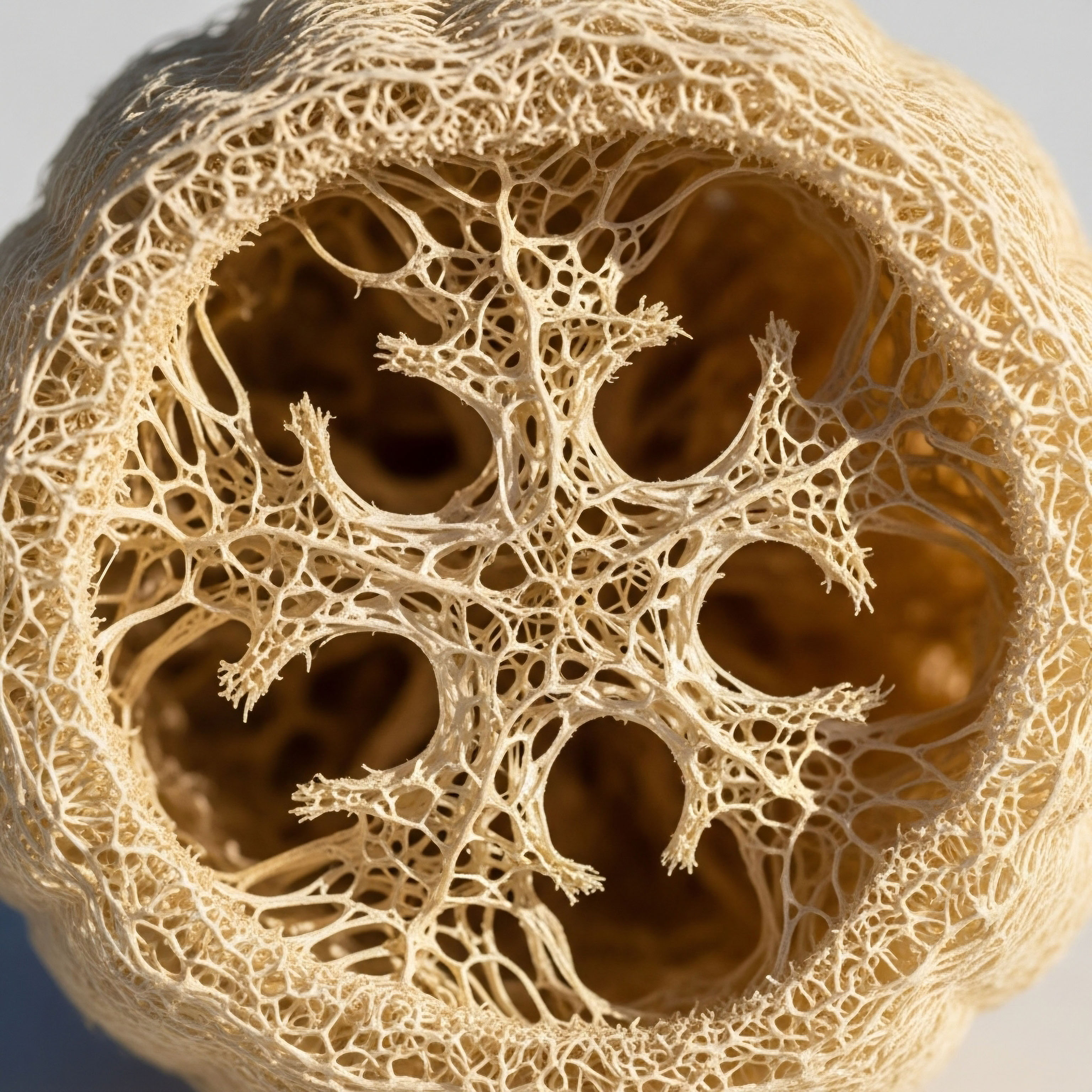

Fundamentals
The feeling is undeniable. A persistent fatigue that sleep does not seem to touch, a quiet fading of drive and ambition, a subtle but definite shift in your physical presence. When you look in the mirror, you may feel that the man looking back is a slightly muted version of yourself.
These experiences are valid, and they are biological signals from your body asking for attention. Your internal world is a finely tuned orchestra of chemical messengers, and testosterone is a lead conductor, particularly for masculine vitality. Understanding how a clinician begins to decipher the cause of its decline is the first step in reclaiming your function and sense of self.
The journey to an answer begins with a conversation, one that connects your lived experience to the intricate biology of your endocrine system. At the heart of testosterone production lies a sophisticated communication network known as the Hypothalamic-Pituitary-Gonadal (HPG) axis. Think of it as a command-and-control system.
The hypothalamus in your brain sends a signal (Gonadotropin-Releasing Hormone, or GnRH) to the pituitary gland. The pituitary, in turn, releases two key messenger hormones into the bloodstream ∞ Luteinizing Hormone (LH) and Follicle-Stimulating Hormone (FSH). LH is the primary signal that travels to the Leydig cells in the testicles, instructing them to produce testosterone.
This entire system operates on a feedback loop; when testosterone levels are sufficient, they signal back to the brain to slow down the initial commands, maintaining a precise balance.
A physician’s initial goal is to understand if a testosterone deficiency originates from the testes themselves or from a disruption in the brain’s signaling pathway.

The First Step the Clinical Dialogue
Before any blood is drawn, the most critical diagnostic tool is your personal story. A doctor’s first task is to listen intently to the symptoms you describe. Reduced sex drive, difficulty with erections, profound fatigue, loss of muscle mass, increased body fat, and changes in mood are all significant pieces of the puzzle.
The clinician will also build a detailed map of your life’s landscape. This includes your sleep patterns, your daily stress levels, your nutritional habits, your exercise regimen, and your use of any medications, alcohol, or other substances. This initial discussion is designed to identify any major stressors on your biological system that could be disrupting that delicate HPG axis communication.

Foundational Blood Work Establishing a Baseline
Following a comprehensive history, the investigation moves to objective data. To diagnose low testosterone, a physician will order a blood test to measure your total testosterone level. Because testosterone levels naturally peak in the morning, this test requires two separate samples drawn between 8 a.m. and 10 a.m.
on different days to confirm a consistently low reading. An acute illness can temporarily lower testosterone, so it is important to be in a state of general health when these tests are performed. This initial measurement provides a clear, quantitative answer to the first question ∞ is there a deficiency?
If the levels are unequivocally low, the investigation deepens, moving from the “what” to the “why.” This is where the true detective work of differentiating between a lifestyle-induced issue and an intrinsic medical condition begins.


Intermediate
Once foundational testing confirms a testosterone deficiency, the clinical investigation shifts into a more granular phase. The central question becomes ∞ where in the HPG axis is the communication breaking down? Is the problem at the source of production (the testes), or is it an issue with the command center (the brain)?
Answering this question is the key to distinguishing between a primary medical condition and a secondary state, which may be influenced by lifestyle factors. This differentiation guides the entire therapeutic strategy, ensuring that the intervention matches the specific nature of the biological disruption.

Decoding the HPG Axis with Advanced Blood Panels
To pinpoint the origin of the problem, a physician will expand the blood panel beyond a simple total testosterone test. This more detailed analysis acts as a diagnostic map of the HPG axis, revealing the health and responsiveness of each component. The key markers provide specific insights.
- Luteinizing Hormone (LH) and Follicle-Stimulating Hormone (FSH) These are the direct communication signals from the pituitary gland to the testes. Measuring their levels is the most important step in classifying the type of hypogonadism. High LH and FSH levels in the presence of low testosterone indicate that the pituitary is trying to stimulate the testes, but the testes are failing to respond. This points toward a primary testicular issue. Conversely, low or inappropriately normal LH and FSH levels alongside low testosterone suggest the pituitary gland is not sending the necessary signals. This points toward a secondary issue originating in the pituitary or hypothalamus.
- Sex Hormone-Binding Globulin (SHBG) This is a protein that binds to testosterone in the bloodstream, rendering it inactive. Only the “free” or unbound testosterone is biologically available to your cells. High levels of SHBG can lead to symptoms of low testosterone even if total testosterone levels appear normal. Factors like aging, liver disease, and certain medications can raise SHBG.
- Free Testosterone This measurement calculates the amount of testosterone that is active and available for use by the body’s tissues. In men who are obese or have diabetes, SHBG is often low, which can make total testosterone appear lower than the biologically active free testosterone level. Assessing free testosterone provides a more accurate picture of the hormone’s functional status.
- Prolactin Elevated levels of this hormone can suppress the HPG axis by inhibiting GnRH release from the hypothalamus. High prolactin may indicate the presence of a pituitary tumor (prolactinoma) and is a critical marker to check when investigating secondary hypogonadism.

Primary versus Secondary Hypogonadism
The results of these tests allow the clinician to categorize the condition, which is a critical step in determining the cause. The following table outlines the key distinctions between the two main types of hypogonadism.
| Feature | Primary Hypogonadism | Secondary Hypogonadism |
|---|---|---|
| Source of Dysfunction | Testicles | Pituitary Gland or Hypothalamus |
| Testosterone Level | Low | Low |
| LH and FSH Levels | High (The brain is calling, but there’s no answer) | Low or Inappropriately Normal (The brain is not calling) |
| Common Causes | Genetic conditions (e.g. Klinefelter syndrome), physical injury to the testes, infection (e.g. mumps), or damage from chemotherapy or radiation. | Obesity, type 2 diabetes, severe stress, obstructive sleep apnea, opioid or corticosteroid use, pituitary tumors, or congenital conditions. |
The distinction between primary and secondary hypogonadism is fundamental, as it separates conditions of testicular failure from those of upstream signaling disruption.

How Can Doctors Tell If Lifestyle Is the Culprit?
Many common lifestyle factors and comorbidities directly cause or contribute to secondary hypogonadism. A clinician systematically investigates these areas because addressing them can often restore normal HPG axis function without the need for direct hormonal intervention. The diagnostic process involves methodically ruling out or addressing these powerful external influences.
For instance, obesity is a major contributor; fat cells produce the enzyme aromatase, which converts testosterone into estrogen, thereby lowering testosterone levels and disrupting the HPG feedback loop. Chronic sleep deprivation, excessive alcohol consumption, and chronic opioid use are all known suppressors of hypothalamic and pituitary function.
A physician will evaluate these variables through detailed questioning and potentially further testing, such as a sleep study for apnea. If a significant lifestyle-related factor is identified, the initial therapeutic approach will focus on modifying that factor ∞ such as a weight management plan, improving sleep hygiene, or reducing alcohol intake ∞ before re-evaluating hormone levels.


Academic
The clinical differentiation between organic, pathological hypogonadism and functional testosterone suppression driven by lifestyle and comorbidity represents a sophisticated exercise in systems biology. It requires the physician to look beyond a single hormone level and evaluate the integrity of the entire neuroendocrine system within the context of the patient’s metabolic health. The investigation progresses from identifying a symptom to characterizing a systemic state, where hormonal deficiency is an output of a broader biological imbalance.

The Metabolic-Endocrine Interface Insulin Resistance and Hypogonadism
A deep understanding of the interplay between metabolic and endocrine health is central to the diagnostic process. Conditions like obesity and type 2 diabetes are not merely correlated with low testosterone; they are causative factors through distinct pathophysiological mechanisms that create a self-perpetuating cycle of dysfunction.
The state of chronic, low-grade inflammation associated with visceral adiposity directly suppresses hypothalamic GnRH pulse generation. Inflammatory cytokines, such as TNF-alpha and IL-6, have been shown to inhibit the neuronal activity required for proper HPG axis signaling.
Furthermore, insulin resistance itself impairs both hypothalamic and testicular function. Hyperinsulinemia can disrupt pituitary LH release, while within the testes, insulin signaling is necessary for optimal Leydig cell steroidogenesis. Therefore, a clinician evaluating a man with metabolic syndrome and low testosterone is observing a state of secondary hypogonadism driven by inflammation and dysfunctional energy metabolism.
The diagnostic conclusion here is that the primary pathology is metabolic. The therapeutic implication is that interventions like diet, exercise, and medications to improve insulin sensitivity are foundational treatments for restoring endocrine health.
A patient’s metabolic health status provides a critical lens through which to interpret their hormonal profile, often revealing the root cause of secondary hypogonadism.

Differentiating Late-Onset Hypogonadism from Comorbidity
Late-Onset Hypogonadism (LOH) is defined as a syndrome in aging men characterized by low testosterone combined with specific symptoms, particularly sexual ones. Differentiating true LOH from the functional testosterone suppression caused by the accumulation of age-related comorbidities is a significant clinical challenge.
As men age, there is a natural, gradual decline in Leydig cell function and a slight deterioration of hypothalamic-pituitary responsiveness. Concurrently, the prevalence of obesity, type 2 diabetes, and cardiovascular disease increases. These conditions are independent causes of secondary hypogonadism.
A rigorous diagnostic approach is required to dissect these overlapping influences. A clinician must carefully assess whether the patient’s symptoms are more likely attributable to the low testosterone itself or to the underlying chronic diseases. For example, fatigue and low libido are symptoms of both hypogonadism and poorly controlled diabetes.
The key is to optimize the management of all comorbidities first. If, after achieving better glycemic control, losing weight, and treating sleep apnea, the patient’s testosterone levels normalize and symptoms resolve, the diagnosis was functional suppression. If testosterone remains low and symptoms persist despite managing these other conditions, a diagnosis of LOH becomes more probable, and hormonal optimization protocols may be considered a more direct and appropriate intervention.

What Are the Limits of Commercial Lab Testing in China?
When navigating hormonal health within specific regulatory and healthcare landscapes, such as in China, understanding the available diagnostic tools is paramount. The precision of the diagnostic process relies on the accuracy and availability of specialized assays.
While standard total testosterone tests are widely available, access to more nuanced measurements like free or bioavailable testosterone, high-sensitivity LH/FSH assays, and reliable SHBG testing can vary. This potential limitation requires a clinician to place an even greater emphasis on the clinical picture ∞ the patient’s detailed history, a thorough physical examination, and a meticulous evaluation of symptoms and comorbidities.
The diagnostic narrative is built by integrating the available lab data with a deep clinical assessment, ensuring that treatment decisions are grounded in a holistic understanding of the patient’s unique biological and lifestyle context.

Advanced Diagnostic Considerations
In cases where initial bloodwork suggests a more complex underlying pathology, further investigation is warranted. For example, profoundly suppressed LH and FSH levels, or significantly elevated prolactin, may trigger a referral for pituitary imaging (MRI) to rule out structural abnormalities like an adenoma. Genetic testing for conditions such as Klinefelter syndrome might be indicated if primary hypogonadism is diagnosed in a younger man. The following table details some of these advanced diagnostic pathways.
| Clinical Scenario | Potential Underlying Condition | Next Diagnostic Step |
|---|---|---|
| Low T, Low LH/FSH, High Prolactin | Prolactin-secreting pituitary adenoma (Prolactinoma) | MRI of the pituitary gland |
| Low T, High LH/FSH (in a younger male) | Klinefelter Syndrome (XXY Chromosome) | Karyotype (chromosome analysis) |
| Low T, Low LH/FSH (with anosmia) | Kallmann Syndrome (congenital GnRH deficiency) | Genetic testing and olfactory function tests |
| History of hemochromatosis | Iron overload affecting the pituitary | Ferritin and iron studies |
This systematic process of escalating investigation ensures that functional, lifestyle-driven issues are addressed appropriately at the primary care level, while patients with evidence of more severe, organic pathologies are directed toward specialized endocrinological care for definitive diagnosis and management.

References
- Cleveland Clinic. “Low Testosterone (Male Hypogonadism).” Cleveland Clinic, 2023.
- “Could you have low testosterone?.” MedlinePlus Medical Encyclopedia, 12 May 2023.
- Nall, Rachel. “8 Major Factors That Cause Low Testosterone Levels.” Men’s Health, 1 Feb. 2023.
- Bain, J. “Diagnosing and managing low serum testosterone.” BCMJ, vol. 52, no. 10, 2010, pp. 523-529.
- Yeap, B. B. “Assessment and management of male androgen disorders ∞ an update.” Royal Australian College of General Practitioners, vol. 44, no. 1, 2015, pp. 34-38.

Reflection
You have now seen the logical framework a clinician uses to interpret the body’s signals. This process moves from your personal experience of feeling unwell to a precise, data-driven understanding of your internal hormonal environment. The knowledge that there is a systematic path to clarity can itself be empowering.
It transforms vague feelings of dysfunction into a set of specific, answerable questions about your own biology. This understanding is the true starting point. Your journey forward involves using this knowledge not as a final destination, but as the map you need to ask better questions and seek a partnership with a clinician who can help you navigate your unique path toward restoring vitality.

Glossary

gonadotropin-releasing hormone

luteinizing hormone

testosterone levels

hpg axis

total testosterone

low testosterone

pituitary gland

fsh levels

sex hormone-binding globulin

shbg

free testosterone

secondary hypogonadism

insulin resistance

metabolic syndrome

late-onset hypogonadism

lh




